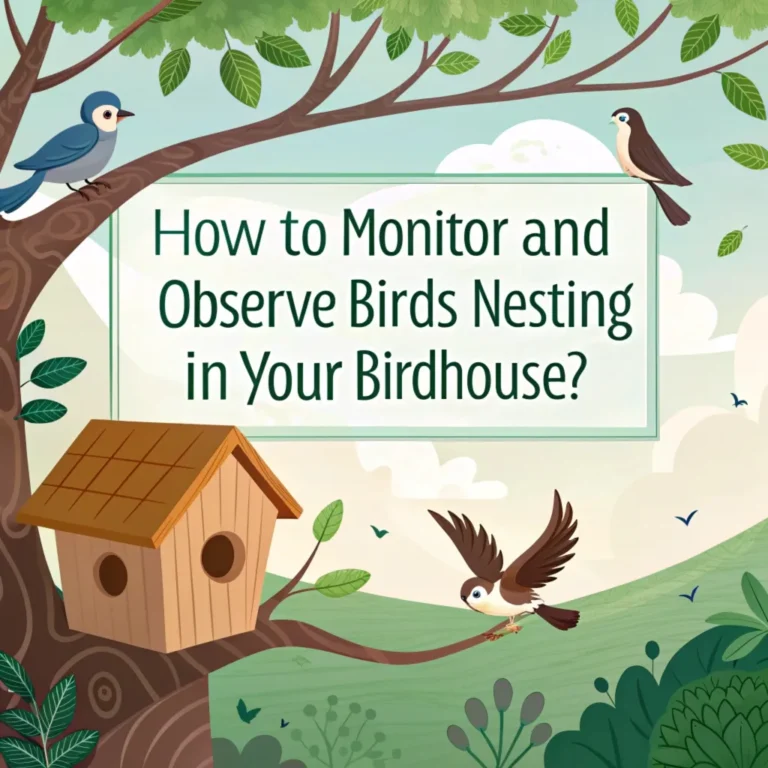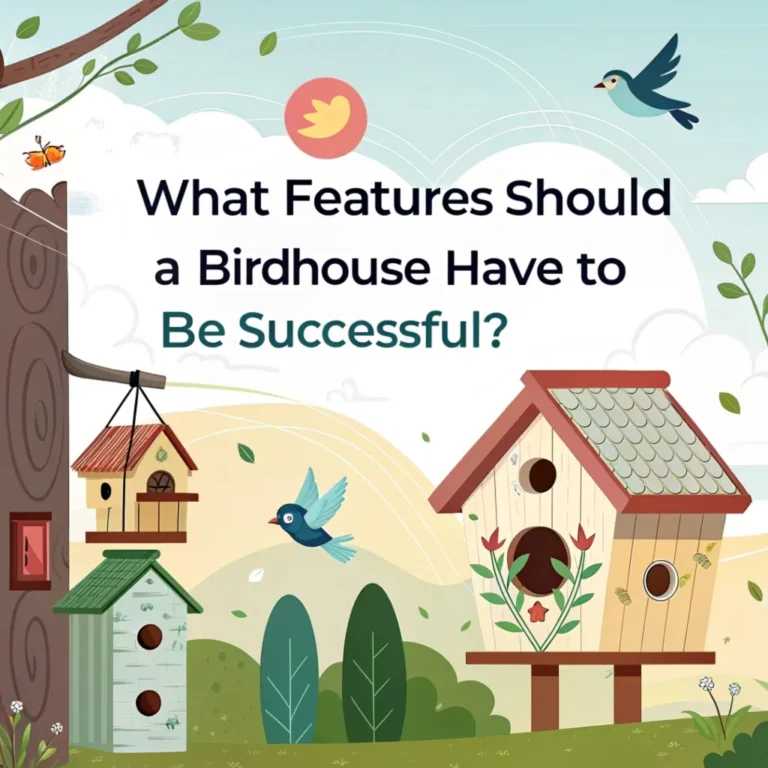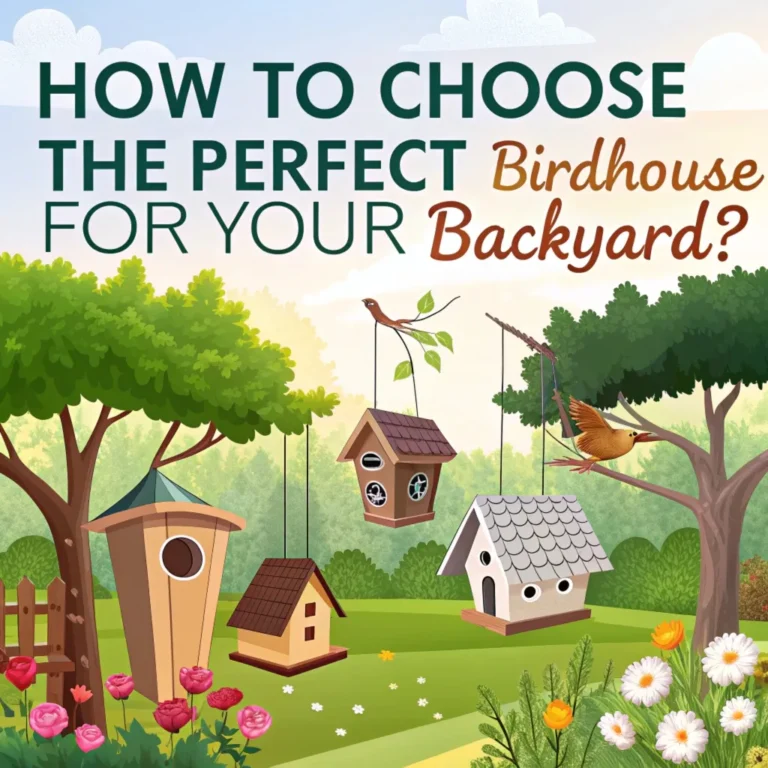What are the Best Types of Birdhouses for Different Bird Species? Find the Perfect Birdhouse
Are you ready to welcome birds to your yard? This guide helps you choose the right birdhouse for different bird species.
Learn how to create safe and comfortable nesting spaces for your feathered visitors. We cover birdhouse designs, placement tips, and maintenance advice.
Let’s explore the world of birdhouses and invite nature’s singers to your backyard.

Key Takeaways: Choosing the Right Birdhouse
- Size matters: Different bird species require specific dimensions for their nesting boxes.
- Entrance hole size: The diameter of the entrance hole is crucial for attracting desired species and keeping predators out.
- Material choice: Wood, especially cedar, is the best material for birdhouses due to its insulating properties.
- Placement: The location and height of the birdhouse significantly impact its attractiveness to different bird species.
- Ventilation and drainage: Proper air circulation and water drainage are essential for a healthy nesting environment.
- Species-specific features: Some birds have unique requirements, such as colony-style houses for Purple Martins.
- Avoid perches: Perches can make it easier for predators to access the nest.
- Maintenance access: Choose birdhouses that are easy to clean and maintain.
- Natural appearance: Birds prefer houses with earth-tone colors that blend with their environment.
- Safety considerations: Ensure the birdhouse design protects nestlings from predators and harsh weather.
Creating a bird-friendly environment goes beyond just providing a suitable birdhouse. Consider the surrounding landscape and natural elements that attract birds. Native plants, water sources, and food availability play crucial roles in making your yard an inviting habitat.
By combining these elements with the right birdhouse, you can create a thriving ecosystem that supports various bird species throughout the year.
Patience is key when attracting birds to new birdhouses. It may take time for birds to discover and accept a new nesting site. Consistency in maintenance and providing a safe environment will increase your chances of success.
Bluebird Birdhouses: A Haven for These Colorful Visitors
Bluebirds need specific housing to thrive. Their ideal birdhouse features:
- Dimensions: A floor size of 5″ x 5″ and a height of 8″ to 12.
- Entrance hole: 1½” in diameter, placed 6″ above the floor.
- Placement: Mount the house 5 to 10 feet high, facing an open field.
- Color: Use earth tones to blend with the environment.
Bluebirds prefer houses in sunny locations with clear flight paths. Place multiple houses about 300 feet apart to accommodate their territorial nature.
Bluebird populations have faced challenges due to habitat loss and competition from invasive species. By providing suitable nesting boxes, you can play a crucial role in conservation efforts.
Bluebirds are not only beautiful but also beneficial to gardens, as they consume large quantities of insects. Monitoring bluebird houses regularly can help ensure successful nesting and protect these charming birds from predators.
Proper placement of bluebird houses is critical. Ensure the house faces away from prevailing winds and has a clear view of the surrounding area for easy insect foraging.
Wren and Chickadee Houses: Cozy Homes for Small Songbirds

Wrens and chickadees share similar housing preferences:
- Size: A compact 4″ x 4″ base with a height of 6″ to 8″.
- Entrance hole: 1⅛” to 1¼” in diameter, located 4″ to 6″ above the floor.
- Placement: Hang 5 to 15 feet high in areas with some cover.
These small birds appreciate houses placed near shrubs or small trees. Wrens are particularly adaptable and may use hanging birdhouses that sway gently.
Wrens and chickadees are known for their cheerful songs and energetic behavior. These small birds are excellent for pest control in gardens, as they feed on various insects.
Providing suitable nesting sites can encourage these beneficial birds to stay in your yard year-round. Consider placing multiple houses to accommodate different pairs, as these species can be territorial during breeding season.
Nest box competition can be fierce among small songbirds. Monitor the houses to ensure larger birds don’t take over nests intended for wrens or chickadees.
Purple Martin Colonies: Apartment-Style Living for Social Birds
Purple Martins have unique housing needs:
- Style: Multi-unit houses or clusters of gourds.
- Apartment size: Each unit should be 6″ x 6″ x 6″.
- Entrance hole: 2¼” in diameter, placed 1″ to 2″ above the floor.
- Height: Mount the colony 15 to 20 feet high in open areas.
These social birds thrive in colony settings. Place their houses away from trees and buildings to reduce predator access.
Purple Martins are fascinating birds with a long history of nesting near human habitations. In eastern North America, they rely almost exclusively on human-provided housing.
Attracting a colony of Purple Martins can provide excellent natural mosquito control, as these birds consume large quantities of flying insects.
Successful colonies often return to the same nesting site year after year, creating a long-term relationship between the birds and their human hosts.
Timing is crucial when setting up Purple Martin houses. In most areas, houses should be opened or put up in early spring, just before the birds return from their winter migration.
Woodpecker Homes: Spacious Dwellings for Cavity Nesters
Woodpeckers require larger houses with specific features:
- Size: Varies by species, but generally 6″ x 6″ to 8″ x 8″ base and 12″ to 24″ high.
- Entrance hole: 2″ to 3″ in diameter, placed 9″ to 16″ above the floor.
- Nesting material: Add 2″ to 3″ of wood chips to the bottom.
- Placement: Attach to tree trunks 8 to 20 feet high.
Different woodpecker species have varying preferences, so research the specific needs of local species.
Woodpeckers play a vital role in forest ecosystems by creating cavities that other birds and small mammals use for nesting. By providing artificial cavities, you can support woodpecker populations in areas where natural nesting sites are scarce.
These birds are also beneficial for insect control, as they feed on wood-boring insects that can damage trees. Consider leaving dead trees or “snags” in your yard, as these provide natural foraging and nesting sites for woodpeckers.
Woodpecker houses should be sturdy and well-insulated to mimic natural tree cavities. Use thick wood and ensure the house is securely attached to prevent swaying.
Swallow Birdhouses: Homes for Aerial Insect Eaters

Tree Swallows and Violet-Green Swallows appreciate:
- Dimensions: 5″ x 5″ floor with a height of 6″ to 8″.
- Entrance hole: 1½” in diameter, 4″ to 6″ above the floor.
- Location: Place near water sources, 6 to 15 feet high.
Swallows benefit from houses placed in open areas where they can easily catch flying insects.
Swallows are excellent flyers and provide natural insect control in open areas. These graceful birds are known for their acrobatic flight and can consume hundreds of insects daily, making them valuable allies in controlling mosquito populations.
Providing nesting sites for swallows can help support their populations, which have faced declines due to habitat loss and pesticide use.
Swallow houses can be a beautiful addition to open landscapes, such as fields or near ponds.
Swallows often nest in colonies, so consider placing multiple houses in suitable areas to attract more birds.
Nuthatch and Titmouse Abodes: Snug Shelters for Forest Birds
These woodland birds prefer:
- Size: 4″ x 4″ base, 8″ to 10″ high.
- Entrance hole: 1¼” to 1⅜” diameter, 6″ to 8″ above the floor.
- Placement: 5 to 15 feet high in wooded areas.
Place these houses in or near forested areas to attract nuthatches and titmice.
Nuthatches and titmice are charming forest birds known for their acrobatic feeding habits. These small birds are excellent for natural pest control in wooded areas, as they feed on insects hiding in tree bark.
Providing nesting boxes can help support their populations, especially in areas where natural cavities are limited.
Both species are year-round residents in many areas, making them delightful backyard companions throughout the seasons.
Consider adding a thin layer of wood shavings to the bottom of the nest box to mimic natural cavities and encourage nesting.
Owl Boxes: Spacious Homes for Nocturnal Hunters
Owls, such as Screech Owls, need larger accommodations:
- Size: 8″ x 8″ base, 12″ to 15″ high.
- Entrance hole: 3″ in diameter, 9″ to 12″ above the floor.
- Height: Mount 8 to 30 feet high on trees or poles.
Owl boxes should be placed in quiet areas away from human activity.
Owls are fascinating nocturnal predators that play a crucial role in controlling rodent populations.
By providing suitable nesting boxes, you can support owl conservation efforts and benefit from their natural pest control services.
Screech Owls, in particular, are adaptable to urban and suburban environments, making them excellent candidates for backyard owl boxes.
These silent hunters not only help maintain ecological balance but also provide enchanting nighttime calls that add to the ambiance of your outdoor space.
Owl boxes require minimal maintenance but should be checked annually for repairs and cleaned if necessary. Avoid disturbing nesting owls during breeding season.
General Birdhouse Construction Tips
When building or selecting birdhouses, consider these important factors:
- Material: Use untreated wood, preferably cedar, for its durability and insulation properties.
- Ventilation: Include small holes near the roof for air circulation.
- Drainage: Drill ¼” holes in the floor to prevent water accumulation.
- Roof design: Angle the roof slightly and extend it over the sides to shed water.
- Access: Include a hinged side or roof for easy cleaning and monitoring.
- No perches: Avoid adding perches, which can aid predators.
- Interior texture: Roughen the inside below the entrance or add mesh to help fledglings climb out.
Proper construction is crucial for creating a safe and comfortable nesting environment. When building birdhouses, pay attention to small details that can make a big difference in the birds’ safety and comfort.
Avoid using toxic materials or paints that could harm the birds or their offspring. Well-built birdhouses can last for many years, providing homes for multiple generations of birds and bringing joy to birdwatchers.
Regular maintenance is key to ensuring the longevity and effectiveness of your birdhouses. Inspect houses annually for damage and make necessary repairs.
Proper Placement and Maintenance
To attract birds and ensure their safety:
- Habitat: Match the birdhouse location to the preferred habitat of your target species.
- Spacing: Place houses for territorial birds at least 50 feet apart.
- Predator guards: Install baffles or guards to deter climbing predators.
- Cleaning: Clean houses annually, typically in late winter before nesting season.
- Monitoring: Check houses regularly during nesting season to ensure they remain secure and predator-free.
Strategic placement of birdhouses can significantly increase their occupancy rates and the success of nesting birds.
Consider the natural behaviors and preferences of different bird species when deciding where to place their houses.
Proper maintenance not only ensures the longevity of the birdhouse but also promotes the health and safety of its occupants.
Regular monitoring can provide valuable insights into the local bird population and their nesting habits.
Be mindful of local wildlife regulations when placing and maintaining birdhouses, especially for protected species.
FAQs About Birdhouses
What is the best time to put up a birdhouse?
Late winter or early spring is ideal, giving birds time to discover the house before nesting season begins.
How often should I clean my birdhouse?
Clean birdhouses once a year, preferably in late winter or early spring before birds start nesting.
Can I paint my birdhouse?
Yes, but use earth-tone colors and non-toxic, water-based paints. Avoid dark colors that absorb heat.
Should I put nesting material in the birdhouse?
Most birds prefer to build their own nests. However, woodpeckers and some owls appreciate a layer of wood shavings.
How can I keep predators away from my birdhouse?
Install predator guards, place houses away from branches that could provide access, and ensure the entrance hole is the correct size for your target species.
Creating a bird-friendly yard is a rewarding experience that goes beyond just providing nesting sites. Consider incorporating native plants, water features, and natural food sources to create a complete habitat.
Observing the birds that visit your birdhouses can be an educational and enjoyable experience for the whole family, fostering a connection with nature and promoting conservation awareness.
Remember that attracting birds is a gradual process. Be patient and consistent in your efforts, and you’ll soon be rewarded with a diverse and thriving bird population in your yard.

Luna is the passionate founder and author of Birds and You, a website dedicated to sharing her love for birds with fellow enthusiasts. Through her engaging articles and guides, she aims to educate and inspire others to explore the fascinating world of birds. When she’s not writing, you can find Luna observing birds in their natural habitats or sharing beautiful bird photography on Pinterest. Join her on this journey to celebrate and protect our feathered friends!







